
Occupy Los Angeles is one of the many occupy movements in the United States, following the original Occupy Wall Street (OWS) protest. Participants of Occupy L.A. first met at Pershing Square on September 23, 2011. Activists came to consensus to occupy public space in solidarity with the growing movement. Occupiers first marched in Los Angeles on September 24, 2011. They next protested a fundraiser being held in Hollywood at the House of Blues for President Obama. Participants met at Pershing Square every subsequent night to plan out the logistics of an occupation set to begin on October 1, 2011. After debating potential locations around Los Angeles, people decided on the lawns around City Hall. Tents first manifested on October 1, 2011 on the grounds of Los Angeles City Hall.

Occupy Portland was a collaboration that began on October 6, 2011 in downtown Portland, Oregon as a protest and demonstration against economic inequality worldwide. It is inspired by the Occupy Wall Street movement that began in New York City on September 17, 2011.

Occupy Seattle was a series of demonstrations in Seattle, Washington, United States in 2011 and 2012, that formed part of the wider Occupy movement taking place in numerous U.S. and world cities at that time. The demonstrations were particularly focused on the city's downtown area including Westlake Park and Seattle City Hall; their stated aim was to oppose wealth inequality, perceived corporate greed, and corruption in the banking and economic systems of the United States.

Occupy Boston was a collective of protesters that settled on September 30, 2011 in Boston, Massachusetts, on Dewey Square in the Financial District opposite the Federal Reserve Bank of Boston. It is related to the Occupy Wall Street movement that began in New York City on September 17, 2011.

The Occupy movement was an international populist socio-political movement that expressed opposition to social and economic inequality and to the perceived lack of "real democracy" around the world. It aimed primarily to advance social and economic justice and different forms of democracy. The movement has had many different scopes, since local groups often had different focuses, but its prime concerns included how large corporations control the world in a way that disproportionately benefits a minority, undermines democracy and causes instability.
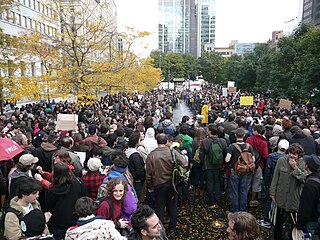
Occupy Canada was a collective of peaceful protests and demonstrations that were part of the larger Occupy Together movement which first manifested in the financial district of New York City with Occupy Wall Street, and subsequently spread to over 900 cities around the world.

Occupy London was a political movement in London, England, and part of the international Occupy movement. While some media described it as an "anti-capitalist" movement, in the statement written and endorsed by consensus by the Occupy assembly in the first two days of the occupation, occupiers defined themselves as a movement working to create alternatives to an "unjust and undemocratic" system. A second statement endorsed the following day called for "real global democracy". Due to a pre-emptive injunction, the protesters were prevented from their original aim to camp outside the London Stock Exchange. A camp was set up nearby next to St Paul's Cathedral. On 18 January 2012, Mr Justice Lindblom granted an injunction against continuation of the protest but the protesters remained in place pending an appeal. The appeal was refused on 22 February, and just past midnight on 28 February, bailiffs supported by City of London Police began to remove the tents.

Occupy Toronto was a protest and demonstration that began on October 15, 2011, in Toronto, Ontario, near Bay Street in Downtown Toronto's Financial District and moved to St. James Park. It was a part of the Occupy movement, which protested against economic inequality, corporate greed, and the influence of corporations and lobbyists on government.

Occupy Philadelphia was a collaboration that included nonviolent protests and demonstrations with an aim to overcome economic inequality, corporate greed and the influence of corporations and lobbyists on government. The protest took place at Thomas Paine Plaza, which is adjacent to Philadelphia's City Hall.

Occupy Eugene was a collaboration that occurred in Eugene, Oregon based on the Occupy Wall Street movement which began in New York City on September 17, 2011. Occupy Eugene included peaceful protests and demonstrations. Protesters were concerned about inequities in the distribution of wealth, banking regulation, housing issues and corporate greed. The first protest march was held on October 15, 2011. The march started at the Wayne Morse Free Speech Plaza and continued downtown before marching over Ferry Street Bridge. It was reported that close to 2000 people were in attendance from all over the state of Oregon. Occupy Eugene continued to hold regular protests and actions until it left the encampment in December 2011. Protesters have stated that they do not have a set group of leaders. Occupy Eugene General Assemblies have met from as frequently as twice a day at times during active occupations, and as infrequently as weekly. Many committees have met since at least the third General Assembly, typically weekly. Decisions are made through a process known as consensus. Occupy Eugene's consensus process operates in a similar fashion to how consensus is being handled in New York City by protesters involved in Occupy Wall Street. Although the exact method varies from Occupation to Occupation. As of October 18, 2011, The Eugene police department was allowing protesters to camp in downtown Eugene, although city law prohibits it. Eugene police also stated that downtown camping won't be permanently allowed.
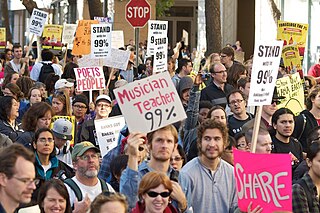
Occupy Oakland refers to a collaboration and series of demonstrations in Oakland, California that started in October 2011. As part of the Occupy movement, protestors have staged occupations, most notably at Frank H. Ogawa Plaza in front of Oakland City Hall.
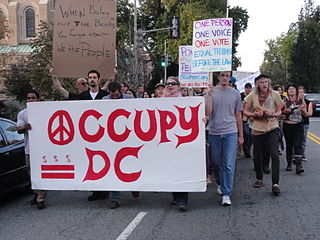
Occupy D.C. was an occupation of public space in Washington, D.C. based at McPherson Square and connected to the Occupy movements that sprung up across the United States in Fall 2011. The group had been demonstrating in McPherson Square since October 1, 2011, and in Freedom Plaza since October 6. Despite crackdowns on other Occupy projects across the country, federal authorities claimed on November 15 that they have no plans to clear McPherson Square Park. The National Park Service decided against eviction after meeting with activists and discussing health and safety conditions.

Occupy San Francisco was a collaboration that began with a demonstration event located at Justin Herman Plaza in the Embarcadero and in front of the Federal Reserve building on Market Street in the Financial District in San Francisco, California. It is based on the Occupy Wall Street movement that began in New York City on September 17, 2011 and is one of several "Occupy" protest sites in the San Francisco Bay Area; other sites include Occupy Oakland and Occupy San Jose.
Occupy San Diego was one of the many occupation protest movements in the United States. Located in San Diego, California, the protest movement initially began in the city's downtown district at the Civic Center. According to authorities, it had "a growing problem with violence and mounting trash". However this assertion was disputed by protesters and eyewitnesses, since Occupy protesters have been actively cleaning the site since October, 2011. It is based on the Occupy Wall Street movement that began in New York City on September 17 and is one of several "Occupy" protest sites in the Southern California, including Occupy Los Angeles.

Occupy Nashville was a collaboration that began with demonstrations and an occupation located at Legislative Plaza in Nashville, Tennessee. Special legislation attempting to oust the Occupy Nashville demonstration passed the Tennessee House of Representatives and Tennessee Senate in February 2012.

The Occupy movement began in the United States initially with the Occupy Wall Street protests in New York City, but spread to many other cities, both in the United States and worldwide. This list article is an alphabetical, non-chronological summary of Occupy events that have occurred in cities in the United States.
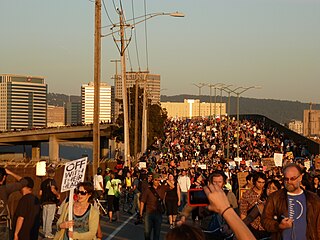
The following is a timeline of Occupy Oakland which began on Monday, October 10, 2011, as an occupation of Frank H. Ogawa Plaza located in front of Oakland City Hall in downtown Oakland, and is an ongoing demonstration. It is allied with Occupy Wall Street, which began in New York City on September 17, 2011, and is one of several "Occupy" protest sites in the San Francisco Bay Area. Other sites include Occupy San Francisco and Occupy San Jose.

Occupy Baltimore was a collaboration that included peaceful protests and demonstrations. Occupy Baltimore began on October 4, 2011, in Baltimore, Maryland, in McKeldin Square near the Inner Harbor area of Downtown Baltimore. It is one of the many Occupy movements around the United States and worldwide, inspired by Occupy Wall Street.

Occupy Minneapolis (OccupyMN) is a grassroots collaboration that began in October 2011 with a series of demonstrations in Minneapolis, Minnesota. Protesters have staged numerous occupations, most notably of the Hennepin County Government Center plaza.
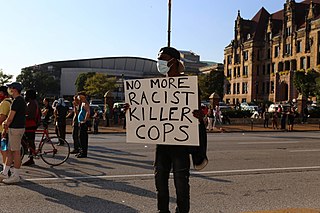
Beginning on the afternoon of September 15, 2017, a series of protests took place in St. Louis, Missouri, following the acquittal of former St. Louis police officer Jason Stockley in the shooting of Anthony Lamar Smith, a black man. Over 160 people were arrested during the first three days of demonstrations, with largely peaceful protests. There has been significant criticism around the police and governmental response to protests, resulting in lawsuits from the ACLU.



















